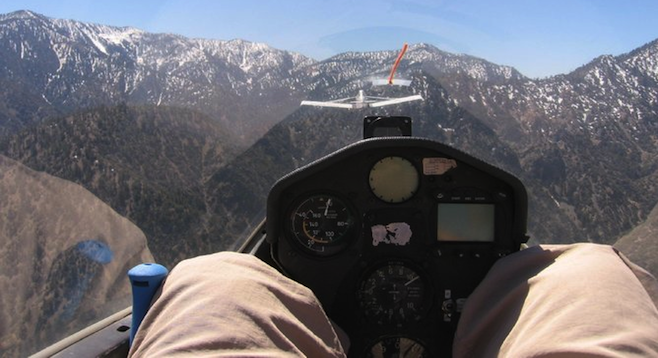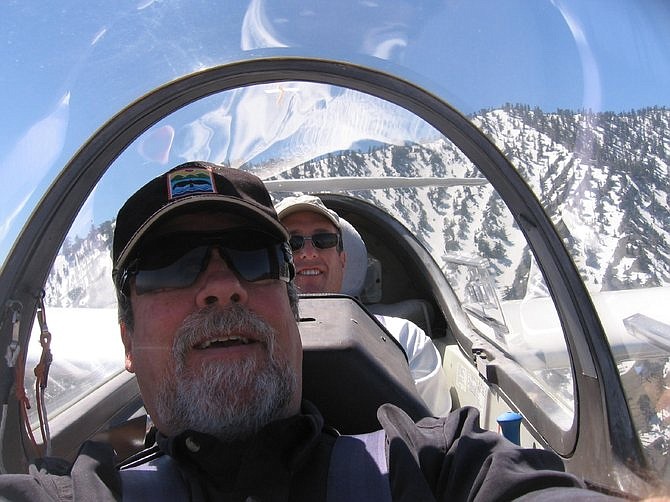 Facebook
Facebook
 X
X
 Instagram
Instagram
 TikTok
TikTok
 Youtube
Youtube

The Air Force prayer has a line that goes, "I slipped the surly bonds of earth and touched the face of God."
That’s pretty heady stuff – but the next time you're feeling trapped by the big city, there's a place close by where you can soar like an eagle and, indeed, break the surly bonds.
The Southern California Soaring Academy is less than a three-hour drive from San Diego in the beautiful Mojave Desert, and a place that gives wings to our flights of fancy. No experience is necessary for anyone, young or old, to spend the day in the sky like a free bird.
Unlike a conventional aircraft, a sailplane (or glider) has no engine. It has a lightweight fiberglass body with unusually wide wings that relies on air currents for propulsion. It is towed into the air attached by a long cable to a propeller-driven plane. Once it has enough altitude, the sailplane pilot pulls a release handle that separates the aircraft from the tow plane where it joins the clouds, staying aloft as long as the ability of the pilot allows it.
The Mojave Desert is a perfect place for soaring as the morning sun warms the cool night air – causing it to rise and slink up the sides of the local mountains, turning into "thermals" or pockets of warm air that lift the aircraft.
An experienced glider pilot can "read" the terrain and know where these thermals are forming. Once the plane is on top of them it can stay aloft for hours. The pilot who took me up told me he once flew from Mojave to southern Colorado nonstop by riding the thermals along the way.
The Soaring Center gliders hold two people. I sat in the front, squeezed into a space that felt molded around my body, almost lying flat and surrounded by a clear glass bubble that gave me a 360-degree view. There was only enough room to move my hands.
The controls are simple: foot pedals to go right or left, altimeter, air speed indicator, horizon level, and a stick for climbing or diving. There is no room for anything extra; it's just you, and you are part of the plane.
With the pilot in control directly behind me, we taxied along the runway behind the tow plane. It was a strange sensation, since I was only about a foot off the ground and with no engine noise could hear the wheels skipping over the tarmac. We climbed quickly and turned north towards the sloping hills that serve as gateway to the Angeles National Forest. I watched a doe and a fawn scramble for cover as our shadow passed over them.

At 4,000 feet, the pilot released our tow line. He had opened a small window to cool the plane before takeoff, but now, at altitude, the sound of the wind coming through that tiny window was deafening. I slid it shut and was instantly struck by the absolute silence followed by a feeling of weightlessness that gliding provides. The silence helps to delude the sense of movement, and for a while I felt suspended in space.
For a full hour we gently climbed, banked, and dove, with snowcapped peaks and blue sky all around. Other gliders tipped their wings in silent passing and I saw red-tailed hawks circling far below us. It was as though we were held aloft by the clouds.
Finally the pilot asked if I wanted to take the controls. I must say here that he was still operating the stick; I was simply allowed to have my hands on the machinery. But the feeling was just as intense as if I were the pilot.
We put the nose into the wind and headed straight for a mountain. Just when I felt we were getting a little close he pulled back on the stick and we shot up over 2,000 feet in just a few seconds, catching a massive thermal along the ridgeline. I was pressed into my seat, facing straight up, and decided this must be a slight version of what a fighter pilot experiences.
The plane responded to the slightest touch and felt like we were willing it to turn or bank and I likened it to riding a thoroughbred stallion more than flying an airplane. In fact I have flown in numerous small engine aircraft and have never felt such a sense of movement and performance as in this glider. I felt we could out-fly any bird in the sky.
Eventually, gravity won out and the ground reached up to pull us down. Our landing was bumpy and noisy and we skidded several yards to a stop, but I've never felt more alive.
All in all, this is a wonderful way to escape the big city for a day without having to travel far, while leaving your troubles on the ground.
If you go: the Southern California Soaring Academy is located at 32810 165th St. East, Llano, CA, at the Crystalaire Airport. They're open Friday through Monday, 9 a.m. till sunset. Lessons are available for those 16 years or older. There is no minimum age to go up for a glider ride, but they do have a 240-pound weight limit.
From San Diego, take Interstate 5 north to Highway 14 (Antelope Valley freeway). Go about 30 miles and take exit 30 for Pearblossom Highway. Go 5.5 miles to Hwy 138 (still Pearblossom Hwy) and bear right for 12 miles. By now you will probably see gliders in the sky around you. Turn right on 165th St. E, and go 1.4 miles to the left turn for the Crystalaire Airport.


The Air Force prayer has a line that goes, "I slipped the surly bonds of earth and touched the face of God."
That’s pretty heady stuff – but the next time you're feeling trapped by the big city, there's a place close by where you can soar like an eagle and, indeed, break the surly bonds.
The Southern California Soaring Academy is less than a three-hour drive from San Diego in the beautiful Mojave Desert, and a place that gives wings to our flights of fancy. No experience is necessary for anyone, young or old, to spend the day in the sky like a free bird.
Unlike a conventional aircraft, a sailplane (or glider) has no engine. It has a lightweight fiberglass body with unusually wide wings that relies on air currents for propulsion. It is towed into the air attached by a long cable to a propeller-driven plane. Once it has enough altitude, the sailplane pilot pulls a release handle that separates the aircraft from the tow plane where it joins the clouds, staying aloft as long as the ability of the pilot allows it.
The Mojave Desert is a perfect place for soaring as the morning sun warms the cool night air – causing it to rise and slink up the sides of the local mountains, turning into "thermals" or pockets of warm air that lift the aircraft.
An experienced glider pilot can "read" the terrain and know where these thermals are forming. Once the plane is on top of them it can stay aloft for hours. The pilot who took me up told me he once flew from Mojave to southern Colorado nonstop by riding the thermals along the way.
The Soaring Center gliders hold two people. I sat in the front, squeezed into a space that felt molded around my body, almost lying flat and surrounded by a clear glass bubble that gave me a 360-degree view. There was only enough room to move my hands.
The controls are simple: foot pedals to go right or left, altimeter, air speed indicator, horizon level, and a stick for climbing or diving. There is no room for anything extra; it's just you, and you are part of the plane.
With the pilot in control directly behind me, we taxied along the runway behind the tow plane. It was a strange sensation, since I was only about a foot off the ground and with no engine noise could hear the wheels skipping over the tarmac. We climbed quickly and turned north towards the sloping hills that serve as gateway to the Angeles National Forest. I watched a doe and a fawn scramble for cover as our shadow passed over them.

At 4,000 feet, the pilot released our tow line. He had opened a small window to cool the plane before takeoff, but now, at altitude, the sound of the wind coming through that tiny window was deafening. I slid it shut and was instantly struck by the absolute silence followed by a feeling of weightlessness that gliding provides. The silence helps to delude the sense of movement, and for a while I felt suspended in space.
For a full hour we gently climbed, banked, and dove, with snowcapped peaks and blue sky all around. Other gliders tipped their wings in silent passing and I saw red-tailed hawks circling far below us. It was as though we were held aloft by the clouds.
Finally the pilot asked if I wanted to take the controls. I must say here that he was still operating the stick; I was simply allowed to have my hands on the machinery. But the feeling was just as intense as if I were the pilot.
We put the nose into the wind and headed straight for a mountain. Just when I felt we were getting a little close he pulled back on the stick and we shot up over 2,000 feet in just a few seconds, catching a massive thermal along the ridgeline. I was pressed into my seat, facing straight up, and decided this must be a slight version of what a fighter pilot experiences.
The plane responded to the slightest touch and felt like we were willing it to turn or bank and I likened it to riding a thoroughbred stallion more than flying an airplane. In fact I have flown in numerous small engine aircraft and have never felt such a sense of movement and performance as in this glider. I felt we could out-fly any bird in the sky.
Eventually, gravity won out and the ground reached up to pull us down. Our landing was bumpy and noisy and we skidded several yards to a stop, but I've never felt more alive.
All in all, this is a wonderful way to escape the big city for a day without having to travel far, while leaving your troubles on the ground.
If you go: the Southern California Soaring Academy is located at 32810 165th St. East, Llano, CA, at the Crystalaire Airport. They're open Friday through Monday, 9 a.m. till sunset. Lessons are available for those 16 years or older. There is no minimum age to go up for a glider ride, but they do have a 240-pound weight limit.
From San Diego, take Interstate 5 north to Highway 14 (Antelope Valley freeway). Go about 30 miles and take exit 30 for Pearblossom Highway. Go 5.5 miles to Hwy 138 (still Pearblossom Hwy) and bear right for 12 miles. By now you will probably see gliders in the sky around you. Turn right on 165th St. E, and go 1.4 miles to the left turn for the Crystalaire Airport.
Comments